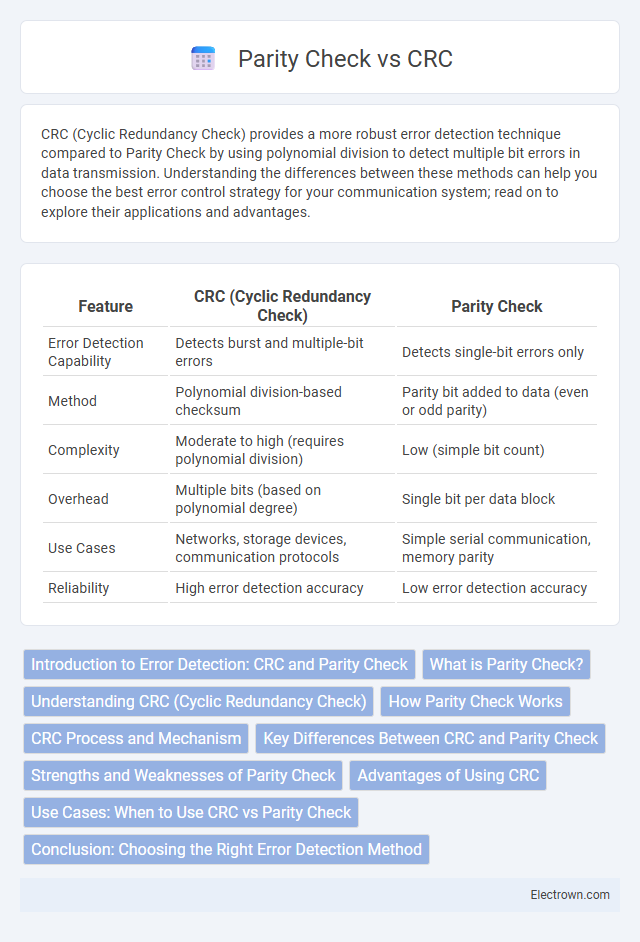CRC (Cyclic Redundancy Check) provides a more robust error detection technique compared to Parity Check by using polynomial division to detect multiple bit errors in data transmission. Understanding the differences between these methods can help you choose the best error control strategy for your communication system; read on to explore their applications and advantages.
Table of Comparison
| Feature | CRC (Cyclic Redundancy Check) | Parity Check |
|---|---|---|
| Error Detection Capability | Detects burst and multiple-bit errors | Detects single-bit errors only |
| Method | Polynomial division-based checksum | Parity bit added to data (even or odd parity) |
| Complexity | Moderate to high (requires polynomial division) | Low (simple bit count) |
| Overhead | Multiple bits (based on polynomial degree) | Single bit per data block |
| Use Cases | Networks, storage devices, communication protocols | Simple serial communication, memory parity |
| Reliability | High error detection accuracy | Low error detection accuracy |
Introduction to Error Detection: CRC and Parity Check
Cyclic Redundancy Check (CRC) and Parity Check are fundamental error detection techniques used in digital communications to ensure data integrity. CRC utilizes polynomial division to generate a unique code that can detect common transmission errors, offering higher reliability compared to the simpler Parity Check, which detects errors by counting the number of bits with value one. Parity Check is limited to identifying single-bit errors, while CRC can detect burst errors and multiple bit alterations, making it a preferred choice in network protocols and storage devices.
What is Parity Check?
Parity Check is an error detection method that adds a single parity bit to a data set to ensure the total number of 1s is even (even parity) or odd (odd parity). It is a simple technique primarily used to detect single-bit errors during data transmission. While efficient for minimal error detection, Parity Check cannot identify multi-bit errors, making it less reliable than more complex methods like CRC (Cyclic Redundancy Check).
Understanding CRC (Cyclic Redundancy Check)
Cyclic Redundancy Check (CRC) is an error-detecting code widely used in digital networks and storage devices to detect accidental changes to raw data. It operates by applying polynomial division to data bits, generating a fixed-size checksum that is appended to the message for integrity verification. CRC is more robust and reliable than simple Parity Check, as it detects burst errors and provides a higher level of error detection accuracy in communication systems.
How Parity Check Works
Parity Check works by adding a single parity bit to a binary data sequence to ensure the total number of 1s is either even (even parity) or odd (odd parity). During data transmission, the receiver counts the number of 1s and compares it with the parity bit to detect any single-bit errors. It is a simple error detection method but less powerful than CRC, which uses polynomial division for more robust error detection.
CRC Process and Mechanism
Cyclic Redundancy Check (CRC) utilizes polynomial division to detect errors by appending a sequence of redundant bits, called the CRC code, to the data frame before transmission. The sender treats the data as a binary polynomial, divides it by a predefined generator polynomial, and sends the resulting remainder as the checksum, allowing the receiver to perform the same division to verify data integrity. Parity Check simply adds a single parity bit to indicate whether the number of ones in the data is even or odd, providing a basic error detection mechanism insufficient for identifying complex error patterns.
Key Differences Between CRC and Parity Check
CRC (Cyclic Redundancy Check) generates a multi-bit checksum based on polynomial division, enabling detection and correction of burst errors, while Parity Check uses a single parity bit to detect only single-bit errors. CRC offers higher error detection capabilities due to its complex algorithm, making it suitable for reliable data transmission in networks and storage devices. Parity Check is simpler and faster but limited in error detection, primarily used in scenarios requiring minimal computational overhead.
Strengths and Weaknesses of Parity Check
Parity check offers a simple and fast error detection method by adding a single parity bit to data blocks, making it effective for detecting single-bit errors. Its primary weakness lies in its inability to detect multiple-bit errors or more complex error patterns, limiting reliability in noisy communication channels. While parity check is computationally efficient, it lacks the robustness and error correction capabilities of CRC (Cyclic Redundancy Check), which provides stronger error detection through polynomial division algorithms.
Advantages of Using CRC
CRC (Cyclic Redundancy Check) offers superior error detection capabilities compared to parity check by identifying burst errors and multiple bit errors with high accuracy. It uses polynomial division to generate a checksum that is more reliable for ensuring data integrity in network transmissions and storage systems. You benefit from enhanced error detection that minimizes corrupted data and improves communication reliability.
Use Cases: When to Use CRC vs Parity Check
CRC is ideal for detecting burst errors in data transmission and is commonly used in network protocols, storage devices, and communication systems where high reliability is crucial. Parity Check is suited for simple error detection in low-complexity systems, such as memory modules and serial communication links, where minimal overhead is required. CRC offers stronger error detection capabilities for complex data streams, while Parity Check is effective for quick, basic error detection in environments with limited processing resources.
Conclusion: Choosing the Right Error Detection Method
CRC offers superior error detection capabilities compared to Parity Check, making it ideal for applications requiring high reliability and data integrity. Parity Check is simpler and faster but best suited for environments with low error rates and limited processing power. Your choice depends on the balance between required accuracy and system resources, with CRC favored for mission-critical data transmissions.
CRC vs Parity Check Infographic

 electrown.com
electrown.com